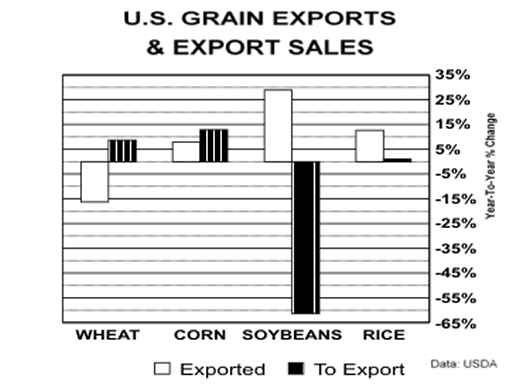Agri-Food Food Trends, Volcano Atmospheric Ash and China 21st Century Demand Miracle
Commodities / Agricultural Commodities May 11, 2010 - 02:15 PM GMTBy: Ned_W_Schmidt
 Our gloom was lifted this past weekend with news that the Icelandic volcano was still pumping away. Got to admire the way it keeps trying, just like the little engine. Ash is now in the skies from near Greenland to Spain, across North Africa, and as far east as Turkey.
Our gloom was lifted this past weekend with news that the Icelandic volcano was still pumping away. Got to admire the way it keeps trying, just like the little engine. Ash is now in the skies from near Greenland to Spain, across North Africa, and as far east as Turkey.
Per Associated Press as reported by ksdk.com, 9 May,“The bulk of the cloud, measuring 2,100 miles long and 1,400 miles wide (3,400 kilometers by 2,200 kilometers), stretched over the North Atlantic, according to the Irish Aviation Authority.”
Experts have claimed that (1) the ash cloud would be over by now, and (2) that no impact of importance would develop. Thus far, expert advice has not been helpful. Is that a surprise?
Ash has now risen to an altitude of 30 thousand feet. At that level it starts to interfere with flights as before the airlines were just flying over it. Ash cloud could also begin to act like a polaroid lens, restricting the free flow of sun light to the earth. Plants need that sunshine to power their photosynthesis. Remember, Agri-Food is not made in a factory.
Closer to the ground, traders in Chicago were surprised to discover that China is now a net importer of corn. China imports corn in two forms, one of which is the natural state. Second means is as Distillers’ Dried Grain(DDG), historically produced by traditional brewers. DDG is also the corn-based residue remaining after ethanol is made. DDG is used as feed for animals. Importing DDG is equivalent of importing corn. China, the demand miracle of the early 21st century, now has a taste for imported corn as it does for soybeans and so many other products.

U.S. corn exports, green corn bar in above chart, are up 5-10% from a year ago. Corn export sales not yet completed, blue bar with vertical black lines, are up almost 10-15% from a year ago. Someone is indeed buying U.S. corn. While Chinese demand for imported corn will not materially alter today’s price for corn, it will over time add incremental demand to the global corn market. Increased demand in the global market for corn should, over time, add support to corn prices. Chinese demand today and Indian demand tomorrow are placing long-term floors under Agri-Food prices.
Before moving on, a comment on soybean bars in that chart. Export sales not yet completed have indeed plunged. Part of reason for that is the other bar, which is for soybeans already exported. U.S. soybean exports this season have increased almost 30% from a year ago. Bins are not empty, but U.S. soybeans are certainly far less available today. With lower U.S. soybean supplies, importers are now turning to the new South American harvest for supplies, as is normally done this time of year. Importers simply bought an inordinate amount of U.S. soybeans earlier this year.

As second chart above portrays, some Agri-Food prices have been moving dramatically higher. Bacon on your sandwiches has been becoming progressively more valuable since Fall. While hog prices have not doubled, it has not been for lack of trying. All meats, while continuing to have seasonal patterns, should experience rising prices over time to compensate producers for higher grain prices coming in the years ahead. Note, Summer is seasonally strong period for hog prices.

The fundamental basis for Agri-Food investments are the prices received for Agri-Food commodities. If that pricing environment is good, Agri-Food investments should be rewarding. As our last chart, below, portrays, Agri-Food prices have been both absolutely and relatively strong for several years. Continuing advance of Agri-Food prices has been occurring for such a period of time as to make reasonable the assumption that higher food price are not an aberration, but rather the norm of today and tomorrow.
With global changes in demand, such as China importing corn, the prospects for future Agri-Food commodity prices are excellent. And then, India’s economic growth will begin to strain the global Agri-Food markets in a few years. Is your portfolio prepared to compete with China and India in the global food markets of tomorrow?
As said above, the basic driver of all Agri-Food investments is the price at which Agri-Food commodities are sold. To gain an understanding a review of our quarterly report on the topic, Agri-Food Commodities: An Investment Alternative, is recommended. You may read that report at this link: http://www.agrifoodvalueview.com/files/..By Ned W Schmidt CFA, CEBS
AGRI-FOOD THOUGHTS is from Ned W. Schmidt,CFA,CEBS, publisher of The Agri-Food Value View , a monthly exploration of the Agri-Food grand cycle being created by China, India, and Eco-energy. To receive the most recent issue of this publication, use this link: http://home.att.net/~nwschmidt/Order_AgriValue.html
Copyright © 2010 Ned W. Schmidt - All Rights Reserved
Ned W Schmidt Archive |
© 2005-2022 http://www.MarketOracle.co.uk - The Market Oracle is a FREE Daily Financial Markets Analysis & Forecasting online publication.



